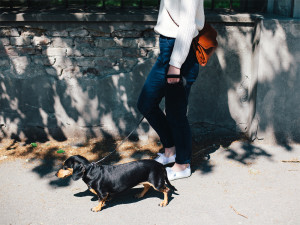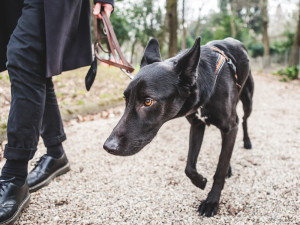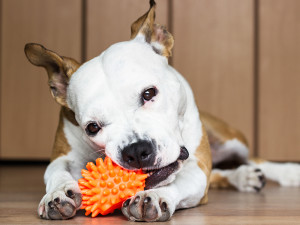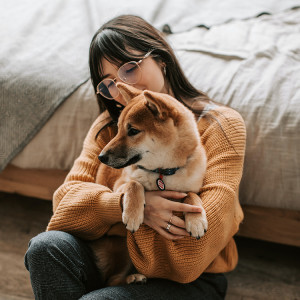How Long Can You Leave a Dog Alone?
Not that you want to be away from them anyway.

Share Article
In This Article:
How Long Can a Dog Stay Home Alone? Factors Affecting a Dog’s Ability to Stay Alone Separation Anxiety in Dogs Frequently Asked Questions
The time you can safely leave a dog alone depends on several factors, including age, health, and personality. As a general guideline, adult dogs can be left alone for six to eight hours, while puppies and senior dogs may require more frequent attention and breaks.
How long can a dog stay home alone?
Although dog parents want to spend as much time as possible with their favorite pup, life often gets in the way. Dogs don’t understand that their parents have to earn money to pay rent and buy important things like dog food, dog treats, dog toys, dog beds, and dog clothes.
Despite not fully grasping the economic and social factors resulting in time apart, most dogs are OK with being left alone for part of the day. But how long is too long for a dog to be home alone?

How many hours can a dog be left alone?
The amount of time a dog can be left alone will vary depending on their age, personality, behavior, and overall health. In general, a healthy adult dog can probably be left alone for six to eight hours.
It’ll take some work and effort to establish a routine and make sure they’re comfortable with that amount of time though. Don’t expect the adult dog you’ve just adopted to immediately be OK with being left for an extended period in a place that’s entirely foreign to them.
How long can a puppy stay home alone?
Getting a puppy is a big commitment, and their need for attention, feeding, and walks is a major factor in the amount of work required to care for them. A general rule of thumb that has been proposed is to not leave a puppy alone for more hours than their age in months (up to six months). There is no scientific evidence to back this up, but this timing seems to work for many puppies and their parents.
It’s important to realize that every puppy is different and that some may not tolerate extended time without attention. Newborn puppies who are still under mom’s supervision can be entrusted to her care for a little longer, but bottle babies need regular feeding, stimulating, and checking to make sure they’re doing OK.
How long can senior dogs stay home alone?
Many senior dogs who are used to spending time alone at home will be OK with resting for six to eight hours during the day. As dogs age, chronic conditions and changes to normal body functions become more common. These factors could affect your senior dog’s ability to remain comfortable at home for as long as they used to.
Legal and ethical considerations
Laws about leaving dogs home alone vary from community to community. Some areas have no protections for dogs at home alone, while others have strict guidelines. Some common guidelines to make sure dogs aren’t suffering include:
General considerations for safety: Dogs should be kept in an area where they can rest comfortably and not be injured inadvertently.
Adequate resources: Dogs must have access to water, enough space to eliminate, and regular feedings
Access to cover: In some areas, it’s illegal to leave dogs outside unsupervised for prolonged periods, especially if they are chained in an open area or in a yard without available protection from the elements.
Pet parents may wonder: “is it cruel to leave a dog alone all day?” This will depend on the dog. Many dogs seem fine with spending time alone and are perfectly happy to curl up for a long rest while their parents are out of the house. Other dogs with separation anxiety or other medical issues cannot be left alone all day without experiencing significant discomfort.
Remote video monitoring can help to make sure your dog is resting and not distressed while you’re gone. Your veterinarian or a veterinary behaviorist can help evaluate your dog’s behaviors to make sure they’re not showing subtle signs of stress when left alone. Although many dogs are OK with spending a workday by themselves, most would likely appreciate some interaction during the day. If possible, this can be provided by a dog walker, a friend or relative stopping by to check on them, or by you on your lunch break.
Factors affecting a dog’s ability to stay alone
Every dog’s tolerance for time alone will be different. A number of behavioral, medical, and environmental factors contribute to their comfort with being left at home.
Health and physical needs
One of the big limiting factors in how much time a dog can spend alone comfortably is their physical needs. Dogs need to pee and poop, and many like to do it on a schedule. This schedule may fit well around your needs, or it may not, but your dog is going to go to the bathroom one way or another. Some common health conditions that can affect how frequently a dog needs to go out include:
Inflammatory bowel disease
Kidney disease
Diabetes insipidus
Bladder stones
Urinary incontinence
Spinal issues
Medications can also make some dogs need to drink and pee a lot more. Diuretics like furosemide (Lasix) or steroids like prednisone will require frequent toilet breaks. Some smaller dogs may be trained to use potty pads indoors, but this tends to not be a great solution for big dogs.
Age
Puppy parents may feel like their growing dogs spend most of their awake time eating, peeing, or pooping. Puppies need very frequent bathroom breaks to prevent accidents and help with house training. Staying on top of their needs can be a pain in the short term, but reinforcing desired elimination behaviors early should pay off for years to come.
Older dogs’ needs change as they age. Senior dogs are more likely to have declining kidney function, sore joints, incontinence, and issues with vision. These conditions mean that they’ll need to pee more frequently, to move around and stretch their legs more regularly, and to be helped navigating their surroundings when light is fading.
Routine
Dogs are most comfortable with a set routine. Knowing what to expect helps to reduce anxiety and makes it easier for dogs to stay alone longer. While some routine variations are inevitable, you can help set expectations for your dog by sticking to the same procedure whenever you leave the house or return. You can try having them lie down calmly in the area they should stay in, giving them a treat, then leaving right after.
Acclimation
Even dogs who are used to being left home during working hours can be upset and act out due to a change in their environment. Moving to a new home is a big upheaval for you and your dog. It’s not surprising that they may be anxious being in an unfamiliar space without you. Try to give your dog time to get used to their new home before leaving them there alone there. When you do start leaving them alone, try to keep initial times short, then increase as they become comfortable with the idea of staying in their new home.
Other environmental changes, construction in the area, visitors, new pets, or bad weather can also upset your dog’s usual routine. Try to be aware of factors that could make your dog uncomfortable with spending time alone and adjust your schedule to help relieve any anxiety.
Companionship
Dogs may be more comfortable spending time without their parents in a multi-pet household. Other dogs can provide companionship, entertainment, and guidance while their people are out of the house. Established companions can be great buddies, but you should be cautious when leaving new housemates alone together. Behavioral issues may come up unexpectedly if you’re not there to watch things.
Individual temperament
You know your dog better than anyone, so you likely have the best idea about how your dog tolerates being alone. Some dogs are so clingy that they’re upset the moment they’re not being held, while others seem to care less if their parents are around as long as the food shows up on time. While most dogs would prefer to be around their parents, some can have an abnormal attachment to them and display undesired behavior when left alone.
Separation anxiety in dogs
Separation anxiety can show up in many ways, but at its root, it’s any unwanted or destructive behavior that manifests due to anxiety that occurs only when a dog is away from their parent. This behavioral disorder can be extremely distressing for both the dog and their parent. It’s best to consult with your vet or a veterinary behaviorist as soon as possible if you suspect your dog is showing signs of separation anxiety. Undesirable behaviors can worsen without appropriate treatment.
Signs of separation anxiety
Some of the most common symptoms of separation anxiety include:
Destructive behavior
House soiling
Lip licking
Yawning
Drooling
Aggression during departure
Escaping
Dogs with separation anxiety may give you some clues to the problem, but it’s often hard to know what they’re up to while you’re away. Video monitoring of their behavior while you’re gone can help to identify this condition.
How to cure separation anxiety in dogs
“Curing” separation anxiety can be difficult. For a moderately to severely affected dog, separation anxiety medication may be recommended to help speed and aid control of symptoms. This medication, combined with behavioral and environmental modification can help your dog learn that it’s OK for you to be away and that you will return to be with them again.
Separation anxiety training for dogs
If your dog has separation anxiety, working with your vet or a veterinary behaviorist is the best way to develop specific strategies for your dog’s anxiety triggers. Some common methods for reducing anxious behaviors include:
Having a consistent departure routine
Ignoring attention-seeking behavior until your dog is calm
Not making a big deal over your dog as soon as you arrive home
Relaxation exercises or cues
Consistent exercise
Gradually increasing separation times
The effects of separation anxiety can severely strain a parent’s relationship with their dog, so it’s important to recognize the symptoms and work with your vet to control them so that both you and your dog are as comfortable and stress free as possible.
FAQs (People also ask):
Is my dog lonely?
Dogs are social animals, and they benefit greatly from companionship. While dogs can tolerate being alone for a little while, it’s best to keep those times limited so they feel included as part of your life.
How to help a dog with separation anxiety?
Separation anxiety is a complex behavioral issue. Dogs with separation anxiety often benefit from a combination of medication and training to find a routine that helps to reduce their stress about being separated from their favorite person.
References:
Video Analysis of Adult Dogs When Left Home Aloneopens in new tab
Puppy Behaviours When Left Home Alone: A Pilot Studyopens in new tab
The Effect of Time Left Alone at Home on Dog Welfareopens in new tab
Barking in Home Alone suburban dogs (Canis familiaris) in New Zealandopens in new tab
Home Safe Home: Treating Canine Separation Anxietyopens in new tab
Impact of Changes in Time Left Alone on Separation-Related Behaviour in UK Pet Dogsopens in new tab

Dr. Bartley Harrison, DVM
Dr. Bartley Harrison is a veterinarian with more than 19 years of experience. He has treated a variety of species in emergency and speciality practices for both large and small animals. His primary interests as a vet are emergency medicine and critical care.
Related articles
![Dog chewing spiked orange toy at home]()
6 Ways to Keep Your Dog Entertained While You’re At Work
Don’t hit pause on your pet’s playtime – these solo activities will help 9-5 fly by for them.
![Tan Chihuahua dog laying on aqua rug looking down shamefully]()
“Why Is My Adult Dog Peeing In The House?”
How to re-housetrain a dog of any age.
![A woman wearing a knit sweater holding a dog close on the floor of her bedroom.]()
Separation Anxiety in Dogs
Train your dog to stay calm when they’re on their own — instead of sad-singing “All By Myself” until you come home.







